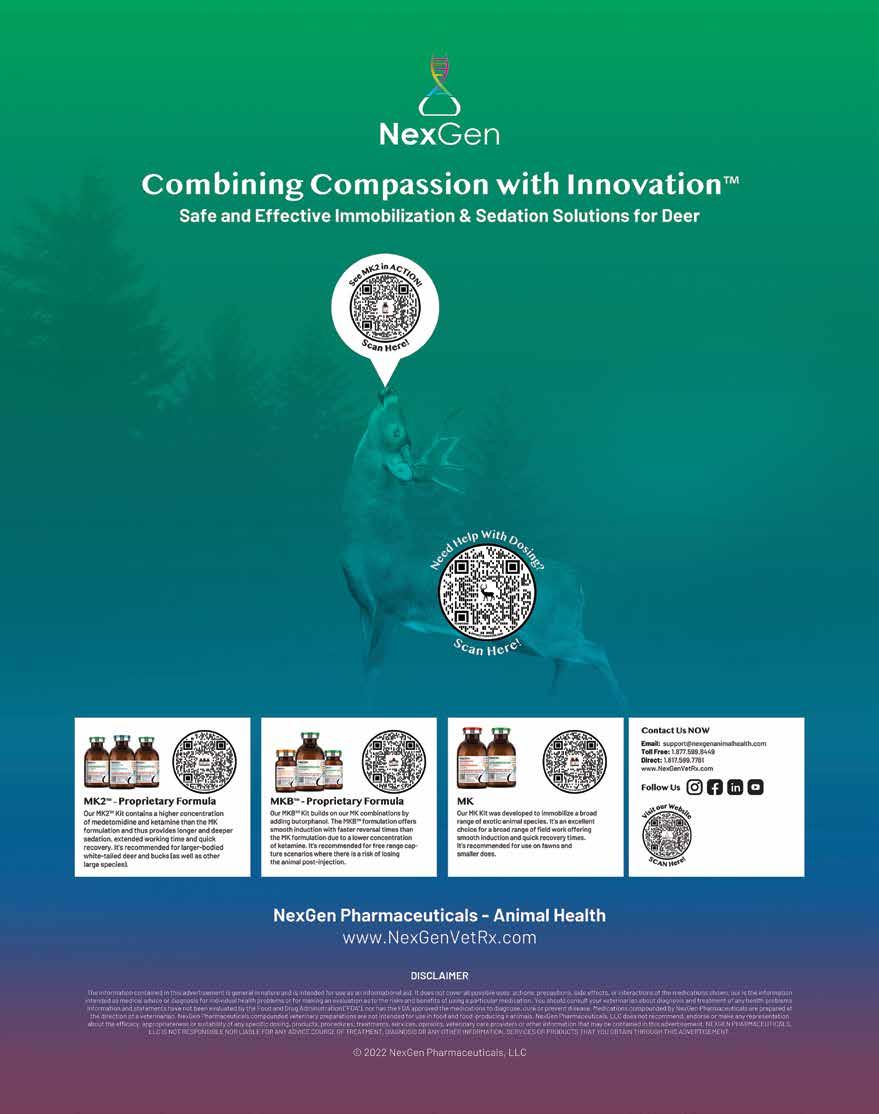






































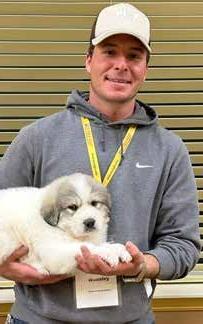
Hello All, on behalf of KALA I would like to thank the North American Deer Farmers Association for hosting another phenomenal conference for 2023! If you missed it or were unable to follow the auction proceedings it was definitely a smashing success! Kentucky was well represented by many phenomenal individuals and some amazing genetics! As we are entering into Spring please go ahead if you haven’t already, and get prepared for fawning season! We are right at 1 month away from seeing fawns on the ground! It is always a good idea to have your fawning tool box fully stocked and ready
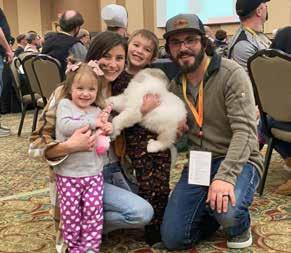


to facilitate your protocol for working fawns. Hopefully you have already ordered your TSU sample tubes from Allflex, and your tags that you will be utilizing for 2023 as well as your immunizers aka: vaccines that you plan on using. We wish you much success in 2023!

If anyone is looking to buy or sell, we now have a KALA Classified section in the magazine! Please contact either me or Josh Moore if you are interested in adding a listing!
Thanks,
Ethan Woosley KALA Magazine Chairman270-230-7978
Jason Becker PRESIDENT Campbellsville, KY jasonbecker757@gmail.com




757-692-5820
Jake Anderson
VICE PRESIDENT 925 Guston Rd Guston KY 40142

janderson@theluskgroup.com
270-547-8432
Chance Groves 11158 New Bowling Green Rd Smiths Grove KY 42171


hdwhitetailbreeders@gmail.com
270-308-0973
David Miller
1873 Forestville Rd
Mumfordville KY 42765
270-537-5357
Joe Miller 4195 Penchem Rd
Guthrie KY 42234
jmgreenlandsod@safecom.link
270-483-2140
Tony Maddox CHAIRMAN
725 Rabbit Town Rd Winchester KY 40391
solidrockwhitetails@yahoo.com
859-556-7253 • 239-340-1171
PRESTON THOMAS SECRETARY
Princeton KY 42445
prestonthomasfarms@gmail.com
270-889-1001
WES BREWER TREASURER
Hodgenville KY 42748
mwb5304@yahoo.com
502-297-1309
Henry Woodard
9776 Roseville Rd Glasgow KY 42141
woodardpropertiestn@gmail.com
423-595-8898
Ethan Woosley
9064 Shrewsbury Road
Leitchfield, KY 42754
Singlecreekwhitetails@gmail.com
270-316-9698


Dustin Blosser enters the fawning facility at Woodard Whitetails and kneels beside their latest spring arrivals. Blosser, a young West Virginia native, may only be 24, but his experience growing up on a pig, cattle and whitetail deer farm, combined with his maturity, has found him in the role of Farm Manager since September of 2021. Now, nestled inside a calving hutch, curious, eager and hungry fawns come forward, some nibbling at Blosser’s arms, jeans and well-worn leather boots. Sticking his face down to their level, he rubs his hair on their heads to make them realize they are fine. They are safe. Then, with hands outstretched, he carefully gathers one in his arms and offers a bottle, precision filled with milk, and attached to a one-inch goat kid nipple, to what he hopes is a fawn who grows up to live a very healthy life.
While raising a healthy group of fawns requires vaccinations and meticulous care, among other things, it also requires an extensive knowledge on the best and safest way to bottle feed, should your farm practice bottle feeding. After receiving colostrum

from their mother for 24 hours, bottle fed doe fawns are typically pulled and placed on a regimented milking schedule, along with struggling buck fawns and sometimes, a third fawn. While every farm may have it’s preferences on feeding times, Woodard Whitetails suggests bottle feeding at 7 a.m., 11 a.m., 3 p.m. and 7 p.m. for the first seven days. And although fawns will drink as much as you choose to offer, problems can occur if you feed them too much, Blosser explained. “We start out with two to three ounces four times a day during the first week,” he said. “They’ll drink whatever amount you give them and if they have too much, they can bloat or milk can overflow into their rumen, and you can kill them. You want to develop their rumen and they won’t if they aren’t eating and just getting all the milk they can ask for. Another important factor is that from Day One we have water and dirt from their pens inside their hutches to help build their immunities.”
Building a fawn’s immunities along with their desire to eat solid food begins slowly during week two, when the schedule shifts to three times a day at 7 a.m., 1 p.m. and 7 p.m. and more milk is gradually offered to the eventual tune of 12 to 13 ounces per feeding. “By the time week three comes around, we are feeding twice a day at 7 a.m. and 7 p.m. and they are eating more solid food,” Blosser said. “Sometimes they don’t make it all the way through week three because they are getting antsy. We make a practice out of giving them a bottle in whatever will become their permanent pen so that they aren’t losing two things at once while also being put somewhere unfamiliar. If you want to keep them really calm,

it’s better this way.” While most fawns adapt immediately to bottle feeding, occasionally there are fawns that don’t. “Rather than putting stress on them by trying to catch them and force the bottle, I just put them back out with Mom and they do fine,” Blosser said. Regardless of how they were raised from birth, Blosser keeps track of each fawn, taking note of their appetite, stool quality or overall health. Should a fawn have diarrhea, Blosser finds that three cc’s of pumpkin baby food usually straightens it out. “You need to watch being too invasive with antibiotics and overcorrecting things,” he emphasized. “It might just kill all the bacteria in their gut. I like to start at the least invasive point and work my way up and see if it’s working first.”
Fawn survival rate at Woodard Whitetails is usually around 95%, said Owner Henry Woodard. “We may lose 5%. This count includes every fawn whether they were born sick or not. Raising fawns is a labor of love and you are handling them and basically replacing their mother and you become attached. If they are sick and you save them, you felt a bond with them. We wouldn’t have a chance to save them otherwise and bottle feeding can give us the best opportunity to stay on top of things.”
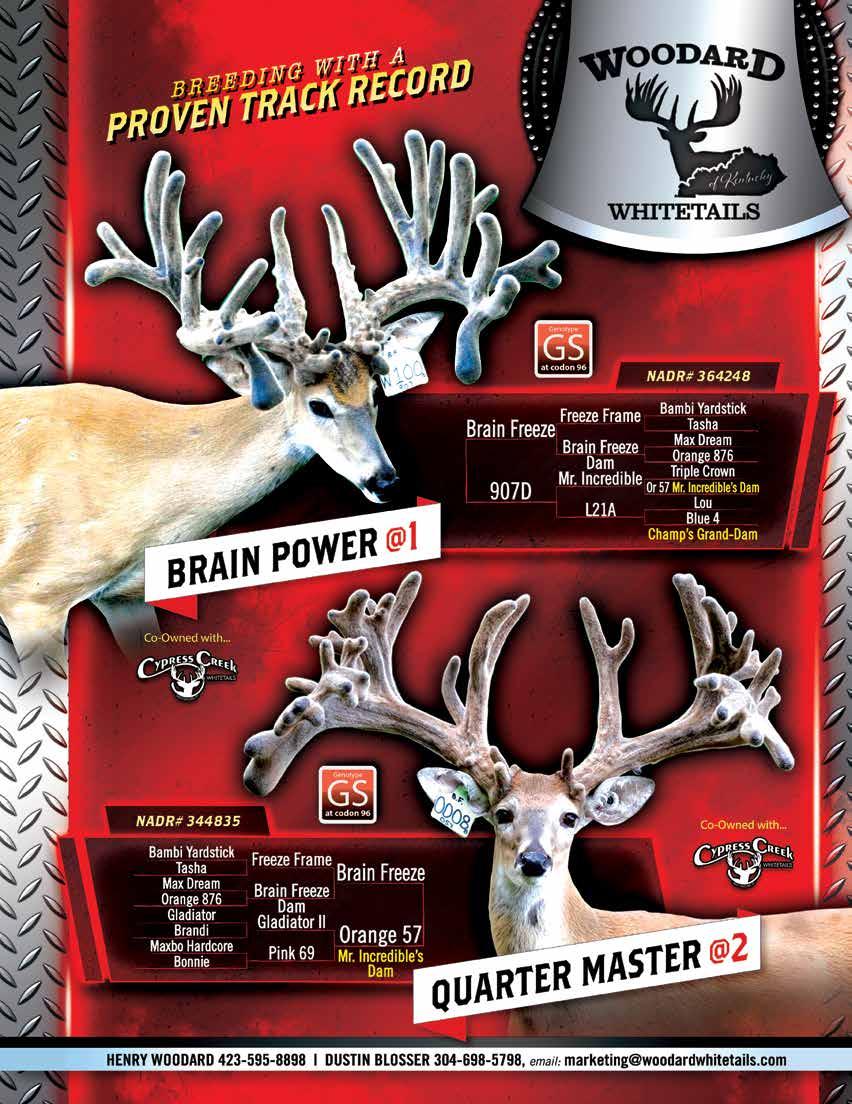


If you would like your farm or business featured on our business card pages, email digital pdf file or scanned image (must be readable resolution) of your business card to:

Ethan Woosley: Singlecreekwhitetails@gmail.com
This gives KALA members a way to reach out to one another for services and to buy or sell deer! There will be limited pages for these card spreads, first come first serve. The overflow would be placed in the next issue and cards will be rotated each quarter.



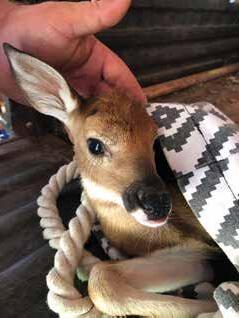
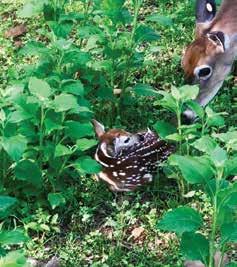 By: Gail Veley • Sponsored by WOO
By: Gail Veley • Sponsored by WOO
Jodi Ezell quietly pauses outside one of her deer pens in the spring twilight, watching and waiting for signs of does ready to deliver fawns. A few does have already started pacing and instinctively creating a safe haven by chasing off other does. However, Ezell is looking for one specific thing as she shares the cool evening with the herd she and her husband Chris raise at Dangerous Whitetails of Oklahoma in Adair, Oklahoma. She is looking for any does with tails lifted and actively pushing, as this starts the countdown for safe fawn arrival. “I give them about an hour of active pushing,” Ezell explained. “If nothing has happened by then, I go in to assist.” Assisting means reaching deep inside the womb, feeling for fawns and helping to pull them out. While an inevitable set of twins is usually the norm, a doe’s history may point to the potential for triplets or quads or perhaps the rare arrival of quintuplets and the necessity to not stop investigating after two.
As these delicate lives receive their first breath of earthly air, Jodi and Chris, who have been through at least 12 fawning seasons, are already taking stock of each fawn and keeping a watchful eye. After 12 hours next to their mother’s
side to ensure colostrum intake, each fawn has hair pulled for a DNA sample, is tagged and given medication. Afterwards, doe fawns and struggling buck fawns are brought inside the Ezell’s bedroom, placed in baby pens and given additional goat colostrum. They will spend the next week receiving a bottle three times a day before being moved to the farm’s fawning facility. Once there, they are introduced to grain as a supplement to their regular schedule of pasteurized goat’s milk, although other farms may opt to bottle feed formula instead. “Around week three we start to feel like their survival rate is more guaranteed,” Ezell said. “By watching them this close for the first three weeks, we are eliminating some of the potential for Mother Nature to do them harm.” This could include the development of scours or even the failure early on to intake enough colostrum to ensure survival.
While fawn arrival may be one of the most rewarding times of the year for deer farmers, it can also be a time when farmers collectively hold their breath as they work to safeguard their health and survival. Although born precocial and able to ambulate practically from the moment they arrive, fawns can also be extremely fragile and may require dedicated care in order to grow into thriving and healthy adult deer.
In addition to proactive fawn care from the moment they arrive, ensuring fawns get the best head start begins with the care of the expecting doe, explains Matt Owens, owner of After Shock deer supplements and Rack Star Whitetails in Sullivan, Missouri. After having been through nine fawning seasons on his farm, his first preparations involve vaccinating all expectant does on March 15th for pneumonia, fusobacterium and clostridium C and D, common cervid
diseases known to cause herd and fawn mortality. A booster shot given on April 5th for each is another safeguard to increase doe antibody levels and allow for the passive transfer of antibodies from mother to baby, he emphasized. “The most important part of preparing for healthy fawns is to have a proven vaccine program and proven feed program for your expectant does,” Owens emphasized. While these measures certainly point to an increase in fawning success “some fawns are still born sick,” Owens said. “Another measure to decrease these odds is to make sure pregnant does also have a good vitamin and mineral program. When you do, fawns are generally born bigger and healthier. Fawns are born with no immune system and not until the 90-day mark do they really develop one. They need all the protection you can give them, including vaccines, until that 90-day mark.”

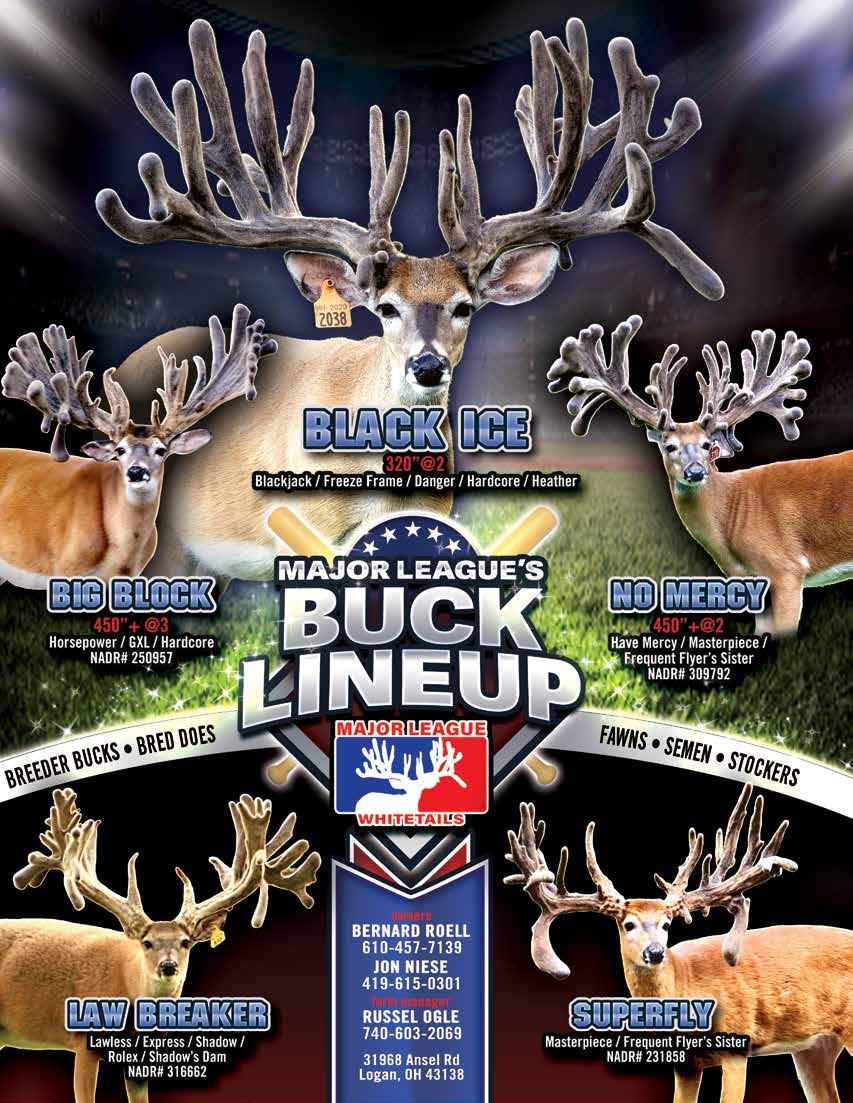


Our disposable RDDs are shorter in length and the lightest on the market thereby providing the ultimate accuracy while reducing the potential for problematic hematomas. Our Slo‑Inject® technology means that your medicine is delivered in the most effective manner possible. Pneu-Dart. Always right on target.


Emmanuel Miller would roll up his sleeves as the hum of his familiar milling machinery would begin on a new day of grinding flour at his beloved and popular mill. It was during an era, in the 1930’s, where milling for flour would soon pave the way for milling pelleted grain for livestock. Weekdays meant long hours and hard work for Emmanuel. Weekends meant outdoor adventures and family time with his wife and children. As the years passed, grandchildren became the focus on those coveted weekends. As Emmanuel nurtured a love of hunting and the outdoors with his young grandson Joe, he was also unwittingly cultivating a lifelong passion for whitetails. As a result, Joe Miller, now 65, has spent the better part of 25 years raising deer at his 15acre paradise, Kentucky Whitetails, in Guthrie, Kentucky.
“My biggest joy is knowing they are out there on this beautiful landscape and that they are healthy and thriving,” said Miller, whose main focus is line breeding and growing clean typical deer. Currently Miller’s herd includes 15 bucks, 43 does and 48 fawns. As a breeder, he’s played his cards so right that the 2022 breeding season did not include A.I., rather just
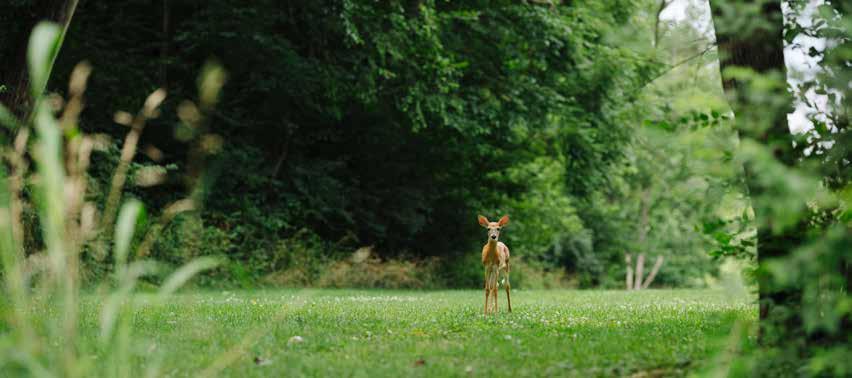
selected and utilized for a consistent and proven outcome.
Some of his prized breeding bucks include five-year-old Second Thoughts who currently measures 386” with 14”-16” tines. “He’s beautiful,” Miller said. “We’re breeding him to select does such as Green 135 who is a Triple Crown and Secret Weapon doe. We also have two huge two-year-old bucks. One is Green 204 out of Brain Freeze on Gladiator Bonnie. The other we call Green 210 out of Brain Freeze on Hardcore Bonnie. He has a real Texas look about him.”
While Miller cherishes his bucks, he feels just as passionate about the quality of does at Kentucky Whitetails. “We have three lines of does that we use to line breed,” he explained. “They are super does and we breed them up to the Bontrager line and Fleece line and their offspring just blooms. We’ve had these lines since 2003. We always carefully watch how we breed.”
In 2022, 50% of the bucks Miller sold were breeding stock while the remaining were sold as stockers. Miller also makes a practice out of selling approximately 20% of his better does in an effort to spread his genetics. However, he will not sell his very best does. He believes
but also through Van Beek natural science mineral enriched livestock feed. He uses it every other week all the way through fawning season and into the first of August, during weaning. Helping Miller continue the success the farm has enjoyed is his wife Ellen and three of his sons, Jonathan, Christopher and Mervin, who also serve as partners. While his other children Rita, Marlin, Celesta, Linford, Leona and Melvin may not share in daily farm duties, they are very proud to support and encourage their parents and siblings in these endeavours.
In his spare time, Miller enjoys gun hunting and trapping animals such as beavers and coyotes during the appropriate trapping seasons. If he were to offer advice to deer farmers, “I would tell them to have the love of the animal and the health of the animal first as priorities,” he shared. “Then, with the breeding side, check on the granddam on the bottom side and see if it was proven. That’s where you can come up with some great offspring. And always look at the does first and not the bucks.”
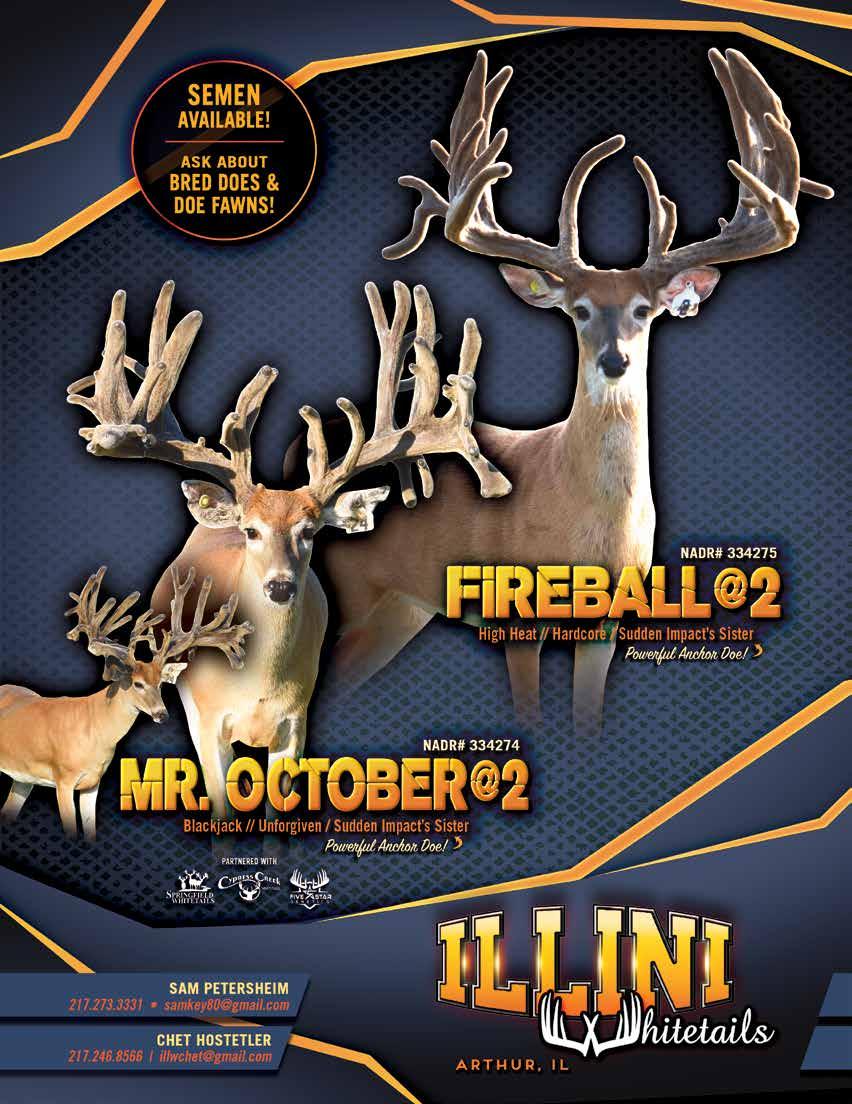
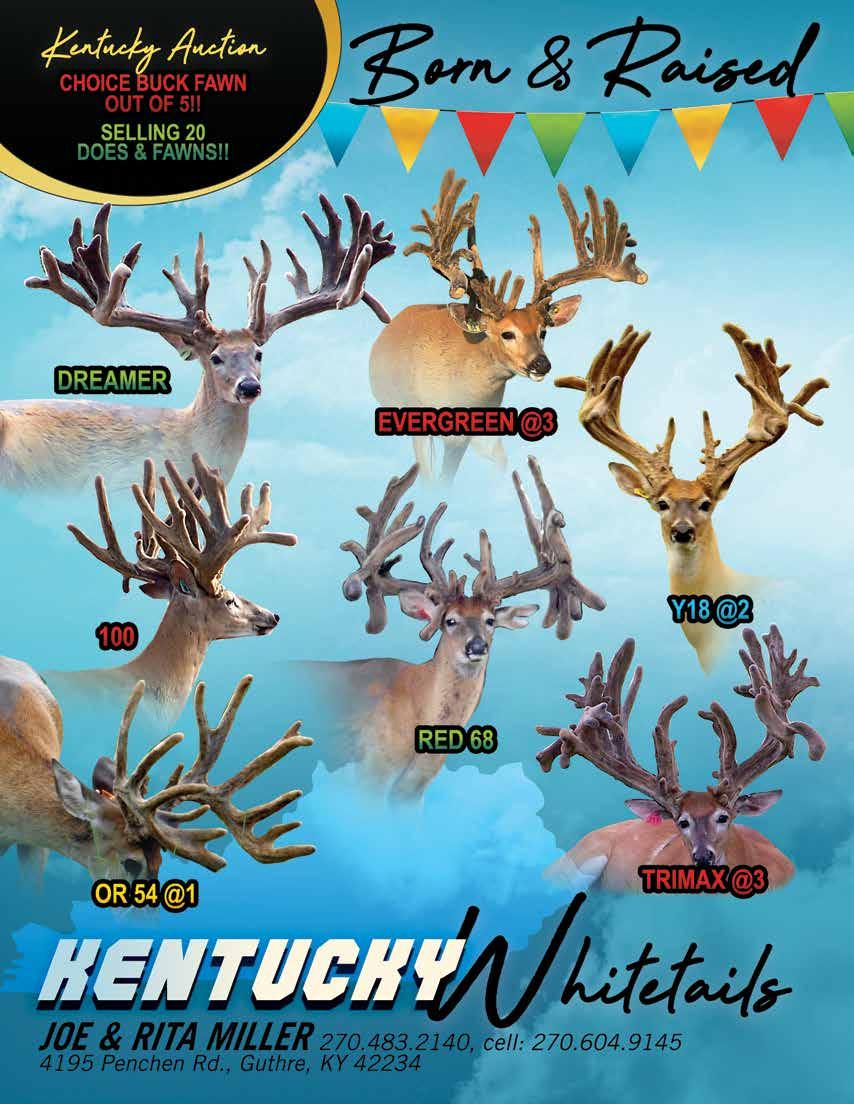
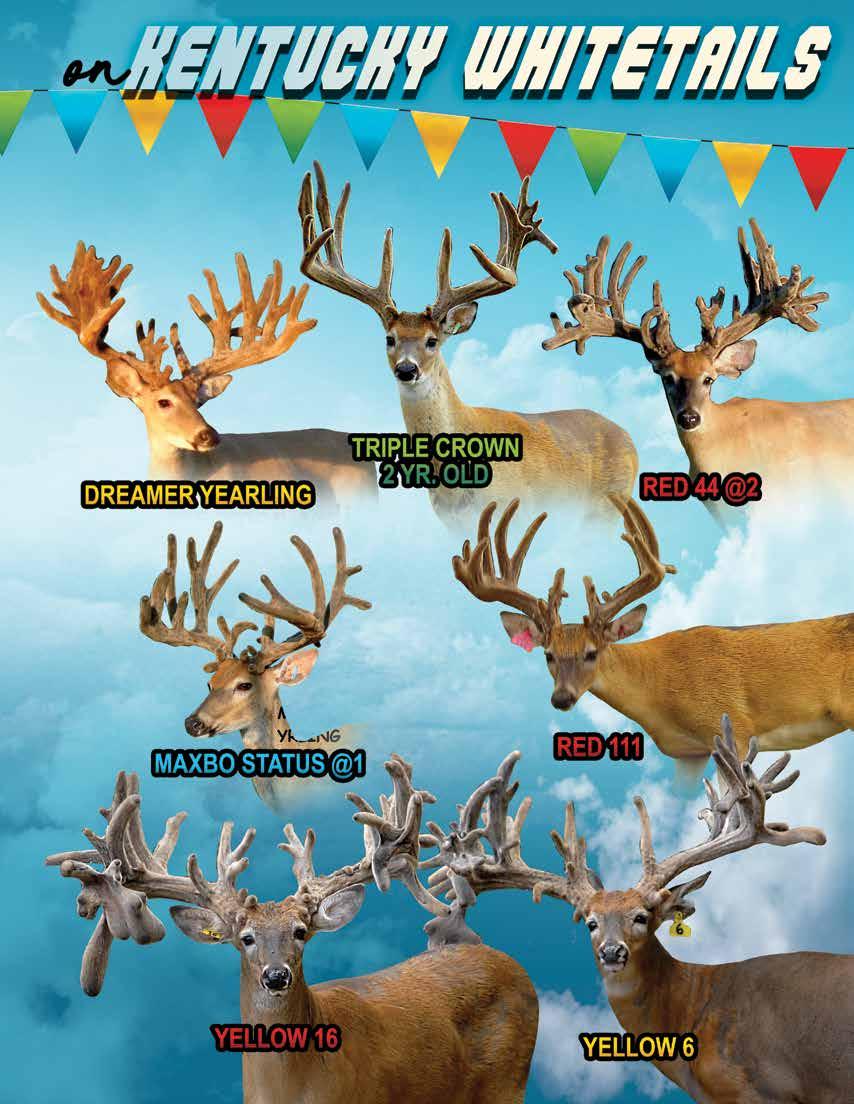
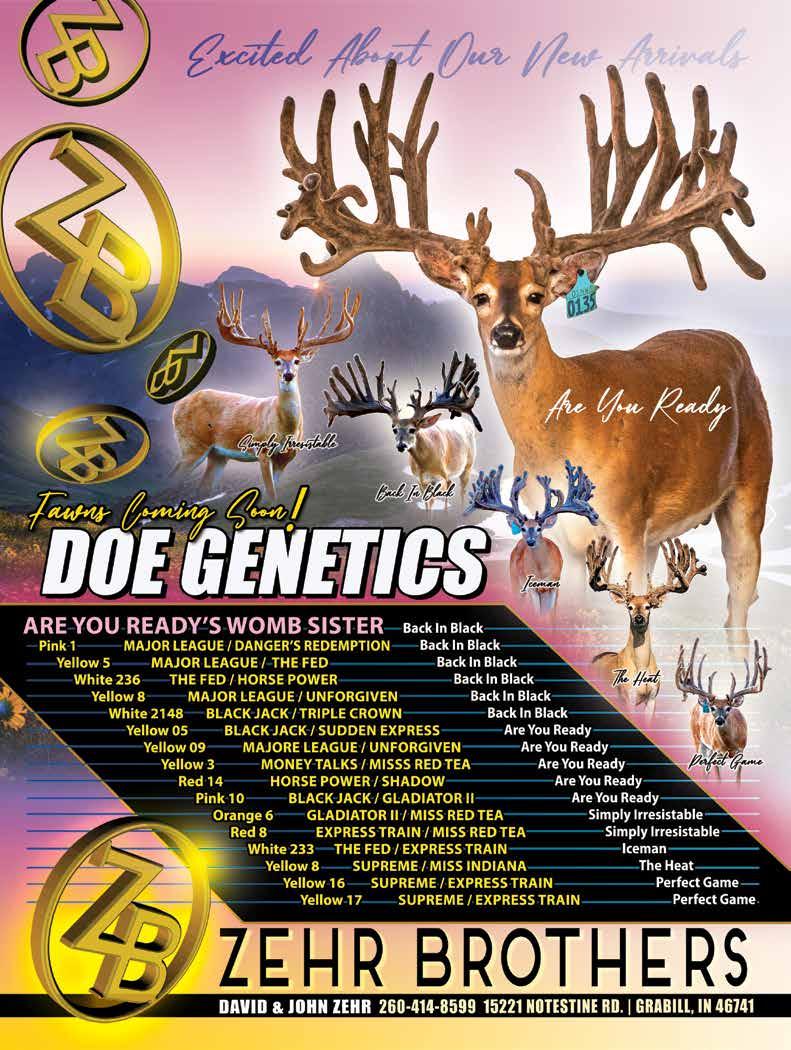
• Fawns up to 1 week of age: Feed 16 oz. of formula daily, divided into 4 – 6 feeding.
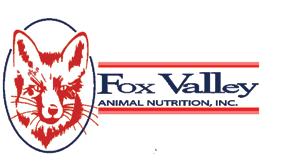
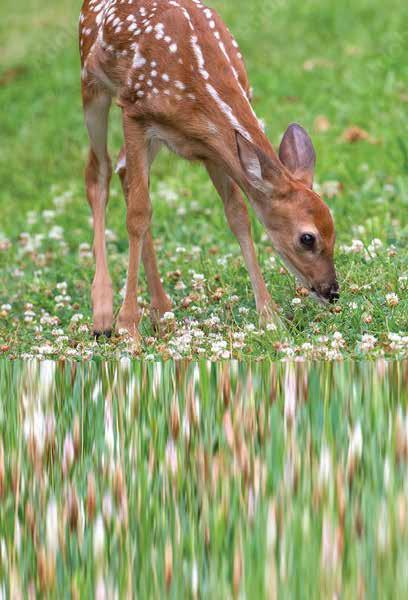
• Fawns 1 week to 1 month of age: Feed 24 to 30 oz. of formula daily, divided into 4 feedings.
• Fawns 1 month to 2 months of age: Feed 30 to 35 oz. of formula daily, divided into 2 to 3 feedings.
• Fawns 2 months to weaning: Gradually decrease formula and number of feedings to approximately 15 oz. of formula once daily until fawn is fully weaned at 12 to 14 weeks of age. Provide a weaning diet and fresh clean water to the fawn. For oral use only. These feeding directions are guidelines. As each animal is an individual, the feeding rate may be increased or decreased according to the needs of the neonate.
Feeding directions for other species can be found on our website.
• All-Milk Protein from Premium Food-Grade Milk Ingredients


• Essential Vitamins and Complex Minerals
• Balanced Fatty Acids
• Improves Digestion
• Promotes Growth and Performance
• No Refrigeration Needed
• Easily Palatable
• 18 Month Shelf Life
• Available in 20# & 8# pails
• 24/7 Technical Advice & Support



Kentucky is known for many things from Bluegrass music, horse racing, coal, and many other things. The culture and traditions that have been handed down continue to live strong in the hearts of many. Townships across America have become known for some of the oftenunique history and continued practices that continue to be passed from generation to generation, but with the onset of technological advancement change has come rapidly. What was once a stagecoach stop in the 1840’s Guthrie, Ky is now not only known for the railroad executive, but it is known for the farming and entrepreneurship that continues to thrive. From sod farming at Greenland Sod, raising whitetail deer at Kentucky Whitetails, to running the trap lines, Joe & Rita Miller definitely live a full and busy life. As Joe says, “you work hard, you play hard!”.
As time swiftly passes, it is all too easy to not live in the moment rather we sometimes find ourselves reminiscing on the past or looking too forward to the future. If you were to ask Joe how fast his 25 years in the deer business have flown by, I am sure he would say it has gone by all too fast. Coon hunting in Ohio with friends that had a cervid facility was the deciding factor that encouraged Joe to develop a vested interest in his deer farm. As he began his journey he became friends with Kevin Grace, and they took tours of several cervid facilities. Much can be learned by visiting a variety of farms, learning how they operate, and seeing how their operation is mapped out. That is one of the biggest hurtles as a new producer, the initial layout of your pens to the layout of your working facility often is changed many times before it is finalized.
Starting out with the best producing does that he could find and afford was the #1 goal for Joe as he and Kevin began their farm visitations. At the time the deer in the industry didn’t have pedigrees, nor could you prove offspring was from a certain lineage by sending DNA to the North American Deer Registry as we do today. As he sought out the foundation to his herd Joe relied heavily on proven production from does that had become known as good producers, and the knowledge and reputations of the farms in operation at the time. As Joe carved out a seat within the cervid industry he became well respected, and humble,
learning much along the way he is definitely a voice to stop and listen to. After all the years as a producer Joe continues to try to steer new and potential farms in the right direction & encourages them to start out with just a couple does that are good solid producers and start from there. Feed a good feed, keep the deer healthy and don’t get carried away with unnecessary products.
As the deer business started taking off for many of us, we all learn that there are certain things we wish we had known prior to our investing in the deer business. Whether it be that we had started earlier, not made a financial decision long since passed, etc. there could be a whole plethora of things that would have proven to have been a benefit. As Joe began his journey, upon seeing the fawns being born, and watching the bucks grow out every year he would have loved to have started in the business a lot earlier.
Farming & being a business owner can be extremely challenging especially if you are farm raising whitetail deer. Challenges and hurtles often rise up out of nowhere and its often at the most inopportune time. The biggest challenge for many farms and for Joe was to learn when you see something, immediately take care of the issue. Unlike cattle, you should act immediately in treatment or resolving the issue at hand, or it can escalate out of control very swiftly. One thing that has proven to
be extremely beneficial for Kentucky Whitetails is to follow up with antibiotics after the initial administration 48 hours later depending on the illness being treated a good follow up is necessary to prevent a rebound or a secondary issue.
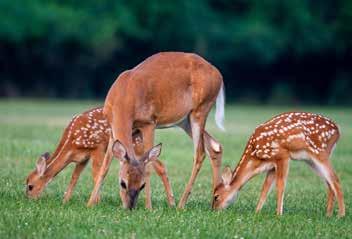
Accomplishing things throughout our lives can mean a variety of things, one of the most challenging and greatest accomplishments is figuring out how to keep your herd healthy and learning that they will produce successfully as a result. Learning how to treat certain issues and how to treat them. All these things have been a challenge for Kentucky Whitetails, but creating lifelong friends within the industry has been a huge accomplishment.
Trying to set goals can be very challenging as a farmer whether it be producing huge 300 inch or bigger deer, or consistently


producing a pen full of pretty typicals As Joe began, he quickly concluded that he wanted to stay as typical as possible, focusing on the quality of the doe herd and their production. Being a producer making sales is crucial to the long-term longevity of the farm one thing Joe attempts to maintain at the time of the sale is to be of a benefit of the buyer. One thing Joe felt should be shared to other producers, much from a personal experience was, whenever something happens in the deer pen that is discouraging always look on the bright side and focus on what you have left. Sometimes everything can be functioning smoothly then EHD may come through and take out a large percentage of
your herd, as Joe put it “just be thankful that it’s not at home” the turbulent times in the deer pens can easily weigh you down to the point of breakage but look on the bright side, be thankful that the turbulence isn’t in your home. Overcoming complications within business is critical to the growth and long term success of your business and the industry as a whole no matter what industry you are in there will always be bumps in the road.
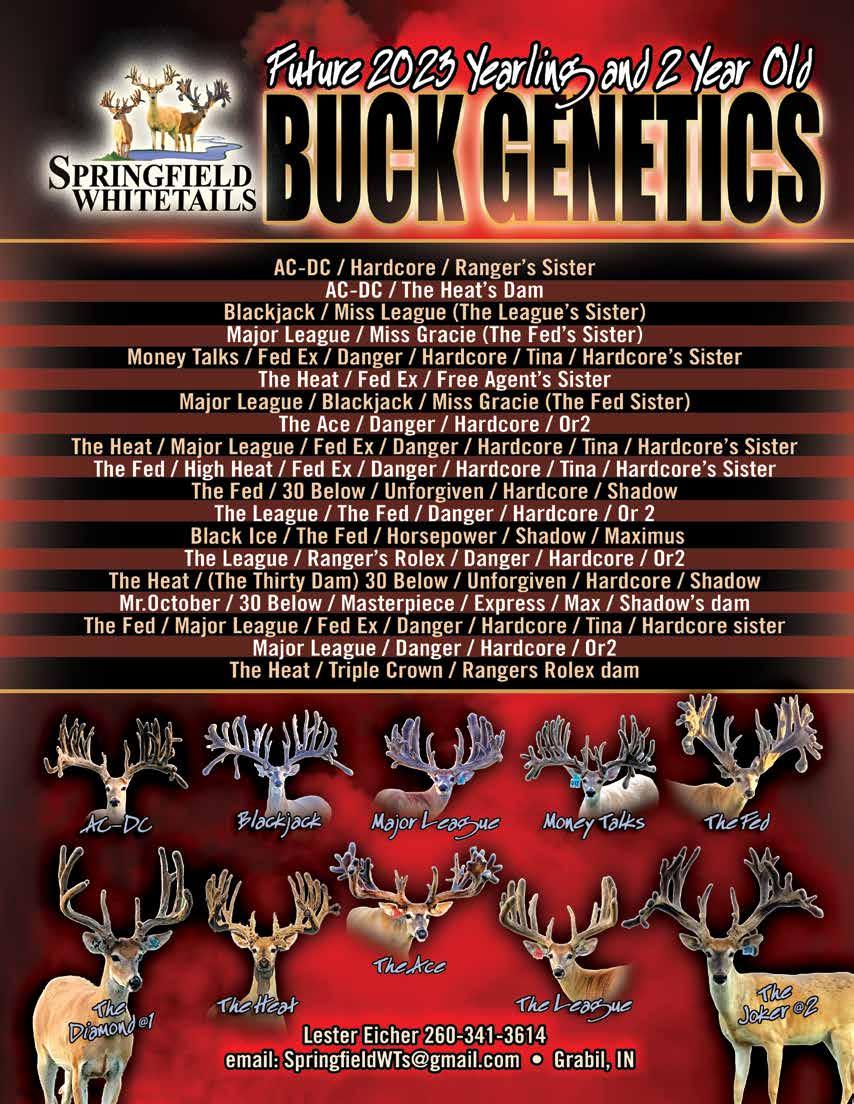
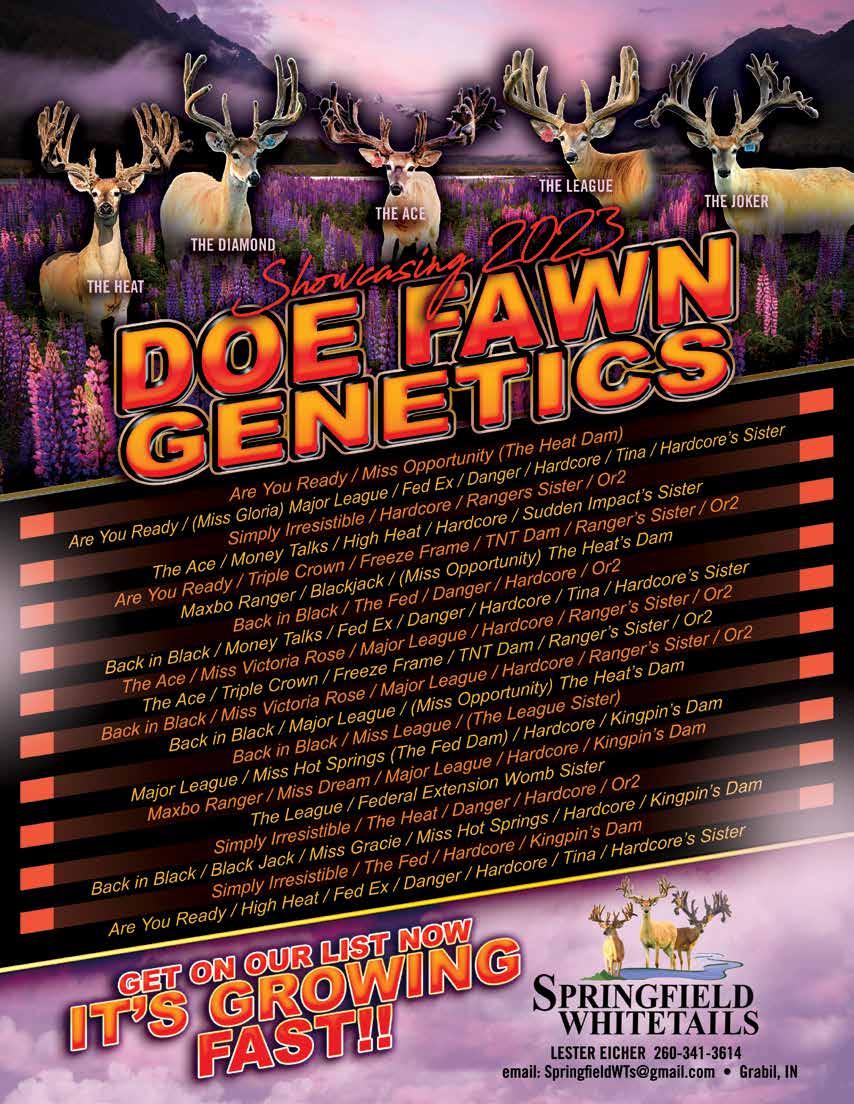
Micr ochips
• USDA 15 digit ISO
• 9 digit Avid and 10 digit Euro. Avid Reader s


• Avid MiniTracker Livestock Reader specially priced.
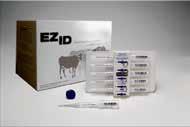
• Blue Tooth® option.
• Dependable Fast, Accurate read EVERY Time!
• U.S.A. made and service.
Coupon: event 21 Limited time offer mention this ad for discount $ave Huge on MiniTr acker Reader and Save $10 on 25 microchip SUDS

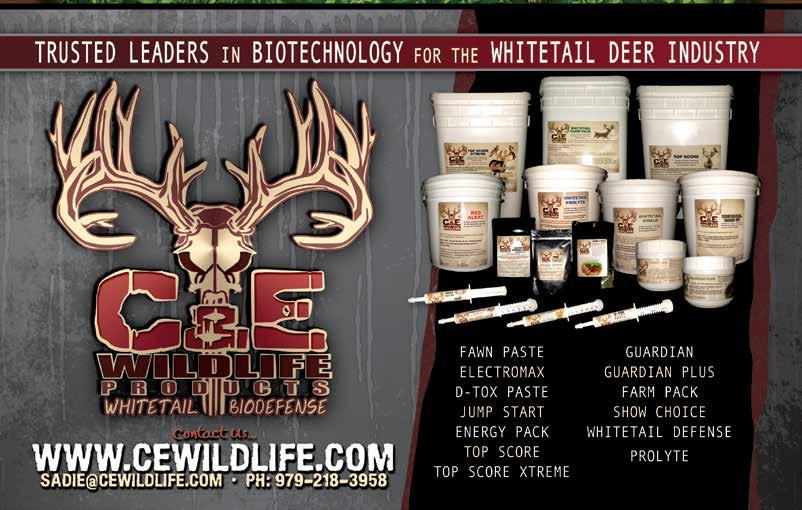
Mention this ad
For limited time only.


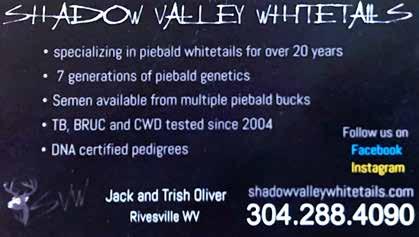

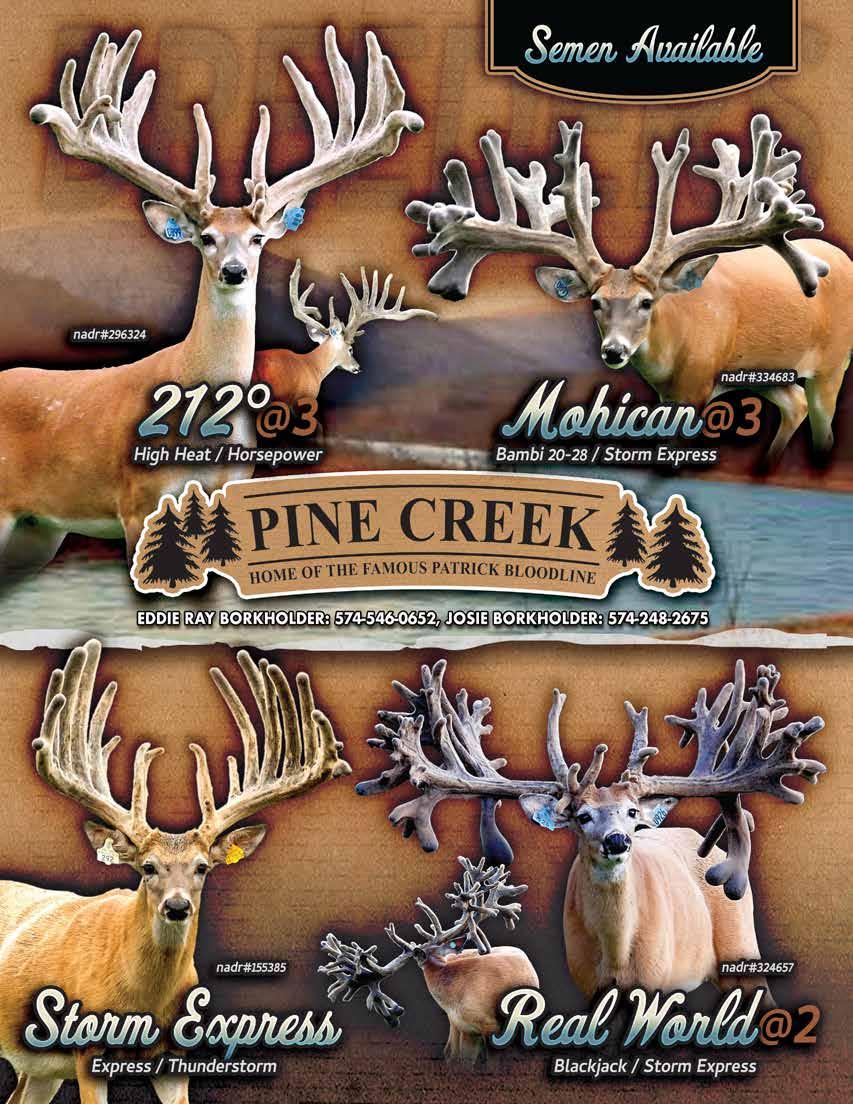


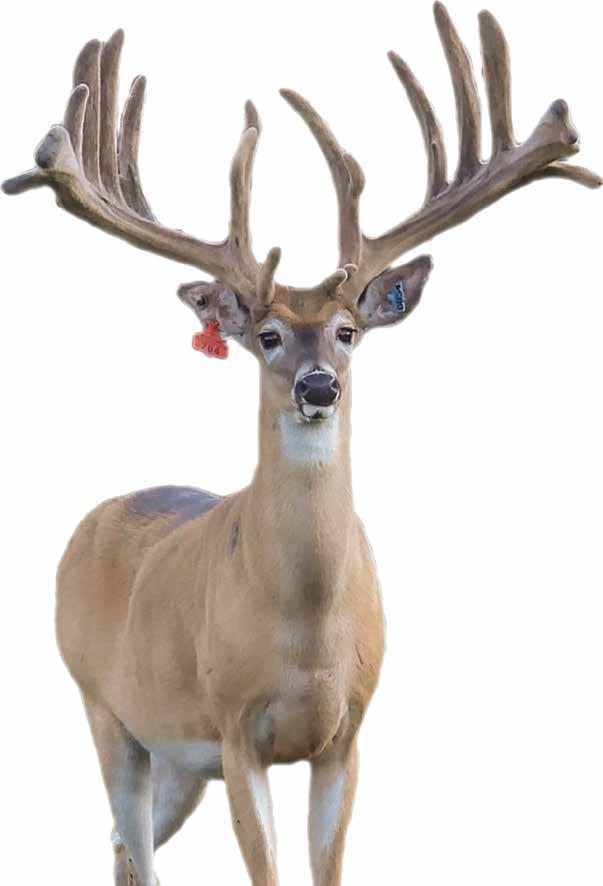
Born and raised in the deer pens! Walking with deer since day one! Ready to go, UTD on vaccinations and worming, comes with a complimentary sampling of the current food!
Single Creek Whitetails call or text

270-230-7978
KENTUCKY BREEDER AND TROPHY AUCTION
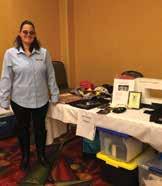
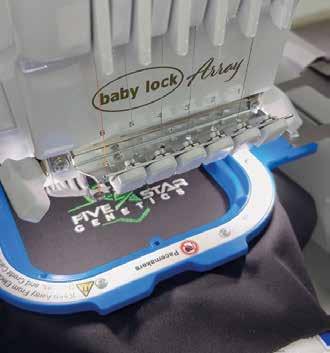

8/24/2023 Location

TBD! Nearly 100 bucks or so expected to be in the sale!

If interested in consigning, please call: David Miller
270-537-5357
Joe Miller
931-444-7707
Steve Chupp Auctioneer
If you would like to place an ad in the KALA Classifieds, please contact Ethan Woosley, or Josh Moore to place an Ad. It is totally Free advertising for KALA members!! If you have a business card and you would like to see it in the magazine section it is also free to KALA members, please contact Ethan Woosley to get those in!
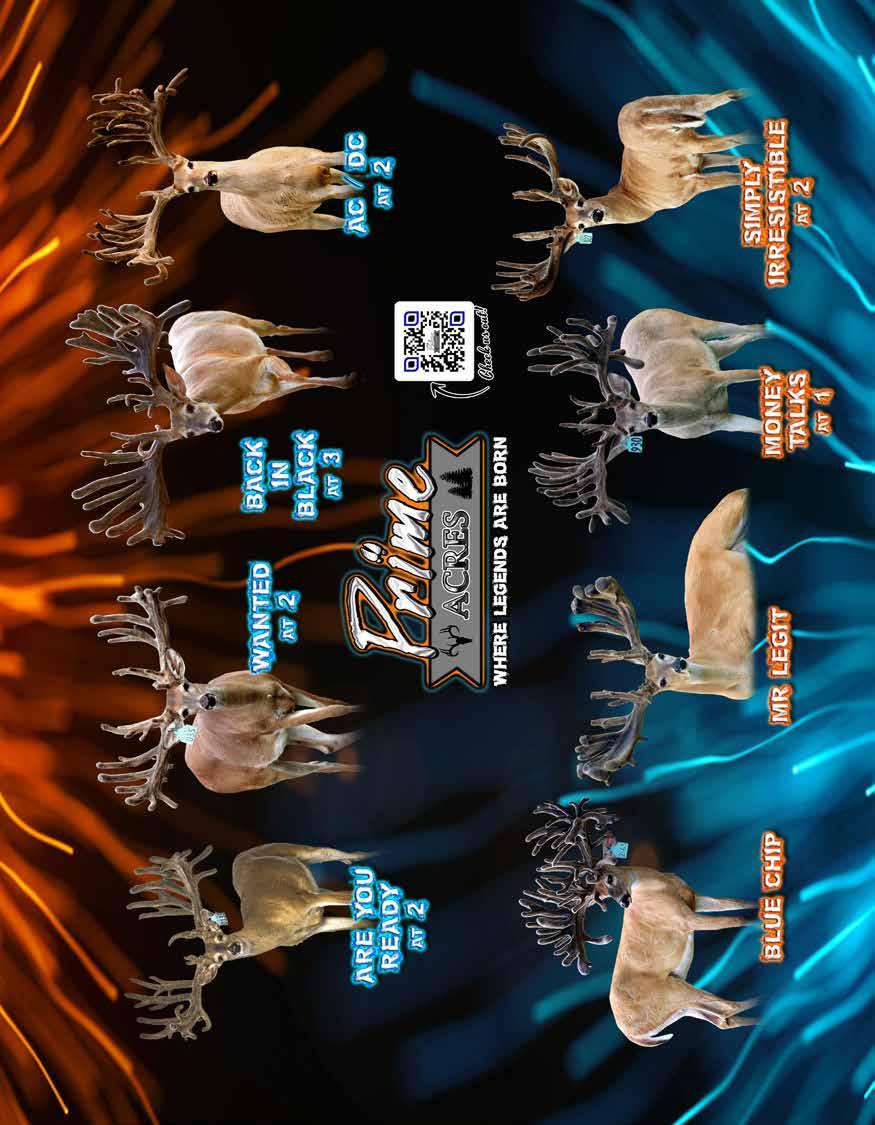
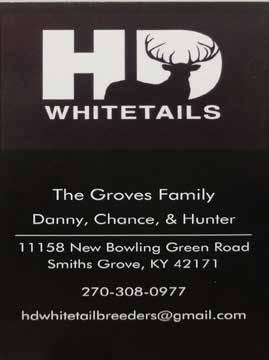


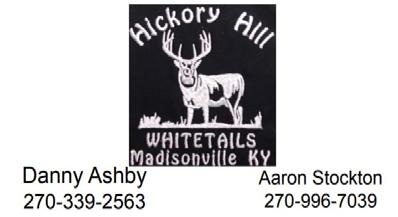
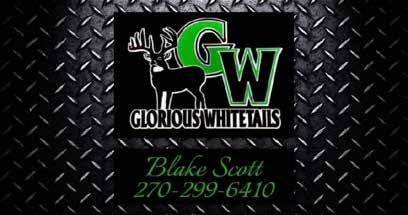
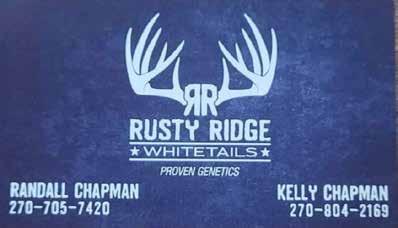
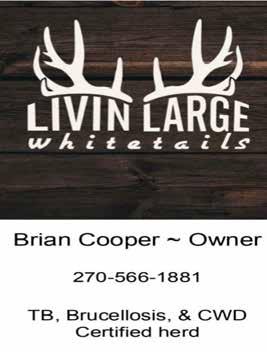


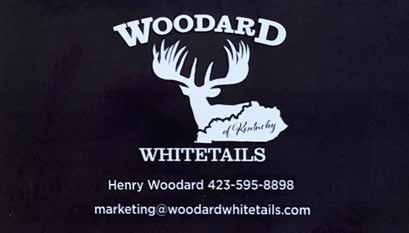
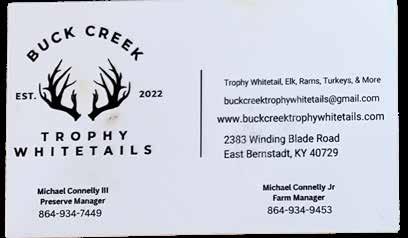

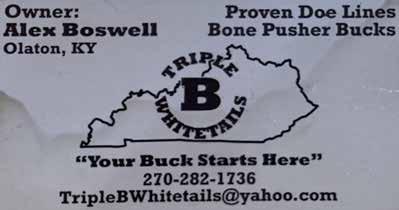


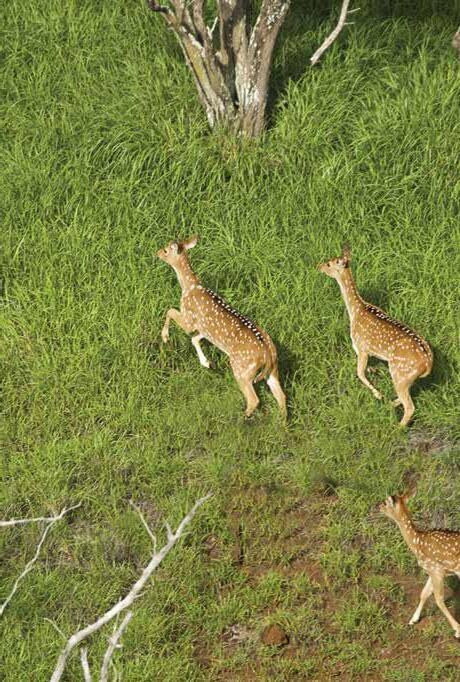
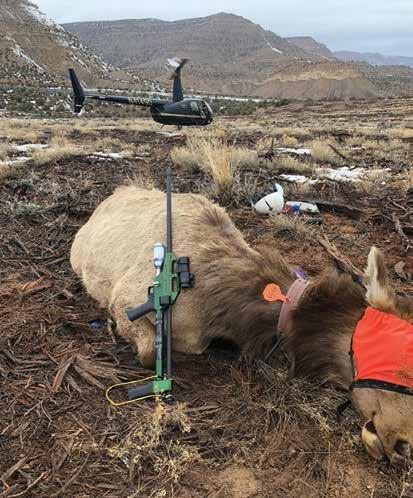
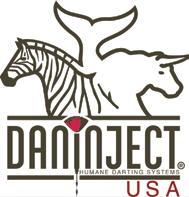














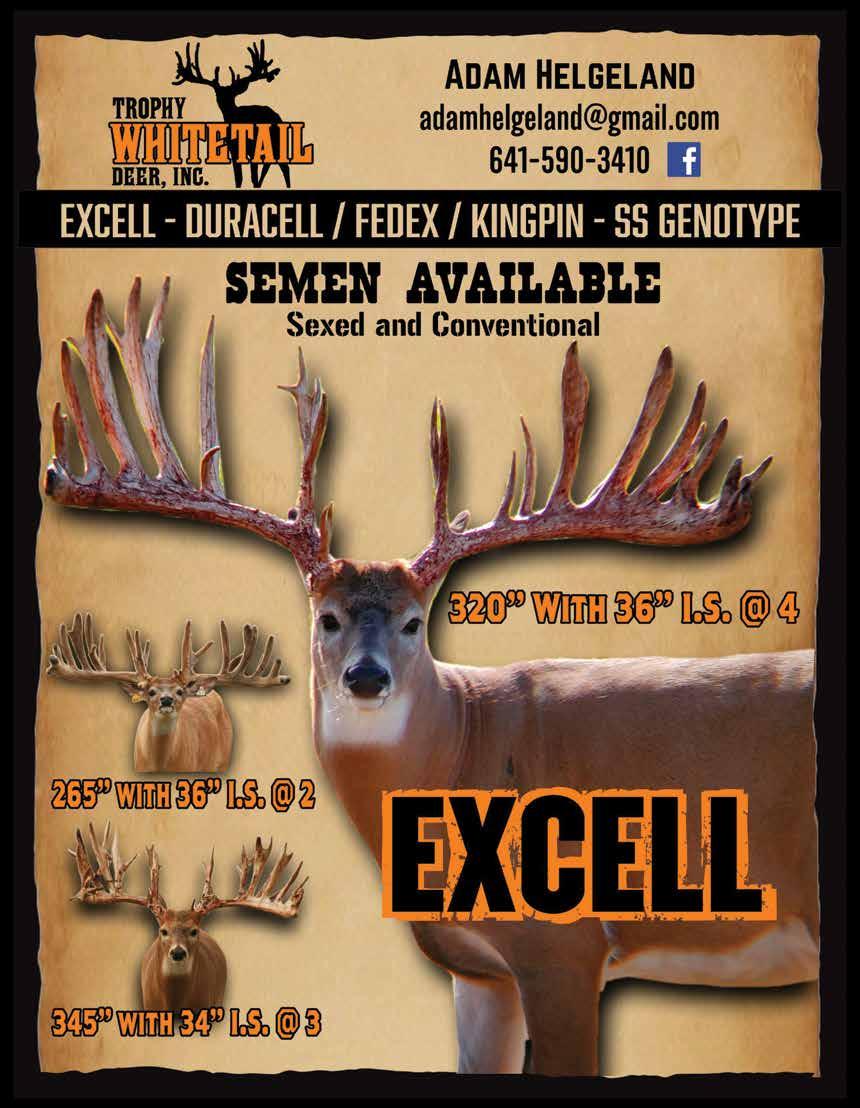



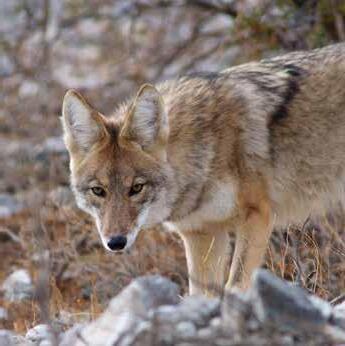
 By: Gail Veley • Sponsored by SETDA
By: Gail Veley • Sponsored by SETDA
When asked whether wildlife predators or cervid diseases are a bigger threat to cervid longevity, SETDA Board of Directors Member Bill Leffler didn’t hesitate to offer an answer. “Can you stop a panther or coyote with a vaccine?” he asked. “We have predators all year long. Not diseases.” At his deer paradise he’s operated for seven years, 2 Base Down Farms in Morriston, Florida comprised of a 107-acre typical breeding farm and 325-acre hunting preserve, Leffler, like all conscientious deer farmers, defines a predator as “anything that can hurt or kill a deer.”
In the warmer, tropical and inviting climate of Florida, a wider variety of predators are more abundantly found than in colder or more northern
climates. According to internet research, the Number One common predator in Florida is the American alligator, where it is estimated more than 1.3 million thrive. Of the 410 recorded alligator attacks on humans in Florida since 1948, 25 resulted in death. “I’ve lost black buck fawns to alligators,” Leffler, 64, said. The second most-deadliest common predator after the alligator is the black bear followed by the bull shark, jellyfish, fire ants, rattlesnakes, ticks, feral pigs or boars, mosquitoes and coyotes. While panthers are also considered a deadly predator, they are also highly endangered with an estimated 120-230 left in the wild, making them more elusive and difficult to reduce.
The Florida Fish and Wildlife Conservation Commission creates, enforces and regulates rules regarding all classes of wildlife within its borders. Yet, no matter what type of wildlife predators may threaten your deer farm, the first step in managing them is complying with the rules and regulations in your particular state regarding their reduction, Leffler emphasized. According to Florida Fish and Wildlife, predation management plans, aimed at reduction rather than elimination, often can be put into play when evidence of predators causes a reduction in game populations, and a regulated harvest of that animal is not adequate control. In addition to following state regulations and protocol for trapping and reduction, deer farmers often design their farms to simply deny predator access. “One of our biggest problems besides coyotes are wild dogs that have been turned loose who form packs,” Leffler said. “The only way to keep them out is to take predator wire and put it on the outside of your perimeter fence with
galvanized wire and hog-ring crimped to the bottom. When a canine attempts to dig under it, it will stop it. Or you can run electrified wire approximately eight to 12 inches off the ground.” Perhaps just as important as sufficient fencing is the comfort that in Florida, coyotes can be shot year-round as they are not protected or endangered. While some deer farmers use crops and blackout or shade cloth to “hide” their animals, it is not nearly as effective as taking the necessary steps to keep them outside your fencing.
In addition to canines, bobcats can cause considerable headaches to deer farmers during fawning season as they can easily climb fences and jump high into the air in pursuit of prey. Florida law permits legal unlimited “bagging” or hunting of bobcats during fur-bearing animal season which runs from December 1st through March 1st each year. However, other fur-bearing animals such as disease carrying raccoons, possums, skunks and squirrels can be hunted year-round and can create even greater risks to deer than migratory birds like ravens, if they urinate or defecate on feed. “In the end, utilizing a licensed trapper to help you can be an invaluable asset. Your best defense is to also know what predators you may be up against, and work compliantly with your state to devise a plan to protect both you and your deer as you reduce the insult to farming,” Leffler emphasized. “Your knowledge and efforts will pay off.”
SCIENTIFICALLY
HELP GROW LARGE, HEALTHY DEER AND BIG ANTLERS!

Nutrient rich formula contains highly bioavailable ingredients, including our proprietary calcium/phosphorous complex with Antler D TM, that are required to support body and bone growth, especially for fast growing bucks

Contains probiotics and targeted enzymes to support gut health and proper digestion
Available in pellet or powder that can be top dressed or mixed in feed. Great for antler growing season and young bucks, too
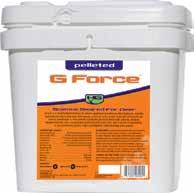
PRECISELY FORMULATED TO HELP MAINTAIN A NORMAL AND RELAXED DISPOSITION IN ALL CERVIDS
Provides optimal levels of magnesium, Vitamin B1 and inositol to promote calmness and provide help for restless animals
Contains no herbals, tryptophan or chemicals, eliminating concerns of unwanted side effects
Use PeaceMaker to “keep the peace” during pre-rut, rut, transportation, weaning and anytime destructive behavior may occur
POWERFUL SOLUTION FOR HEALTH & PRODUCTIVITY
Helps maintain digestive health and productivity
Contains micro-encapsulated probiotics, targeted enzymes and a novel fiber complex
Use in does before fawning, during lactation and all cervids during times of environmental stress
FAWN ARRIVAL™ POWDER &
HELPS PRODUCE HEALTHY, FAST GROWING FAWNS
Helps maintain normal digestive health
Supports a healthy immune system
Feed powder for 14 days to bottle fed fawns

Paste is ideal for fawns left on does

FAWN & DEER XTR™
ROBUST FAST RESPONSE FOR FAWNS & OLDER DEER

Innovative formula delivers max digestive support, especially in newborns
Rapidly delivers help for GI health and a functioning immune system
May also be used post-tranquilization to support healthy recovery
